
Innovators Win Prism Awards
SAN FRANCISCO, Jan. 27, 2010 -- Ten cutting-edge products in nine categories, including optics, lasers, and photonics systems, were named the most innovative of 2009 Wednesday night during the second annual Prism Awards ceremony.
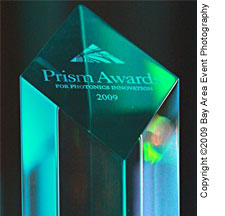 The awards, co-sponsored by Laurin Publishing and SPIE, were presented during a gala ceremony held during SPIE Photonics West at the Hilton San Francisco and attended by approximately 400 leaders of the photonics industry. The Prism Awards honor photonics innovation. Judges from SPIE and the advisory board of Photonics Spectra magazine reviewed and ranked applications from more than 100 companies, looking for shining examples of innovation in specific fields. Ten awards were presented in nine categories; there was one tie, in the Analytical, Test and Measurement category.
The awards, co-sponsored by Laurin Publishing and SPIE, were presented during a gala ceremony held during SPIE Photonics West at the Hilton San Francisco and attended by approximately 400 leaders of the photonics industry. The Prism Awards honor photonics innovation. Judges from SPIE and the advisory board of Photonics Spectra magazine reviewed and ranked applications from more than 100 companies, looking for shining examples of innovation in specific fields. Ten awards were presented in nine categories; there was one tie, in the Analytical, Test and Measurement category.
The 2009 Prism Award winners are:
Lasers
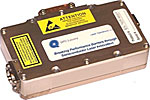 Laser Operations LLC-QPC Lasers for the Brightlock Ultra-G, a compact, athermal, multiwatt green (532 nm) laser with near-diffraction-limited beam quality based on on-chip wavelength stabilization of high-brightness laser diodes. The Ultra-G series is specifically designed for medical, military and defense applications that require high-power green light in a compact, passively cooled package. Benefits of the Ultra-G include its passive cooling system, its small size, low power consumption and cost effectiveness.
Laser Operations LLC-QPC Lasers for the Brightlock Ultra-G, a compact, athermal, multiwatt green (532 nm) laser with near-diffraction-limited beam quality based on on-chip wavelength stabilization of high-brightness laser diodes. The Ultra-G series is specifically designed for medical, military and defense applications that require high-power green light in a compact, passively cooled package. Benefits of the Ultra-G include its passive cooling system, its small size, low power consumption and cost effectiveness.
In honor of the 50th anniversary of the birth of the laser, the Laser Prism Award was presented by Kathleen Maiman, widow of Ted Maiman, whose husband invented the first working laser, a ruby laser, in 1960.
Optics
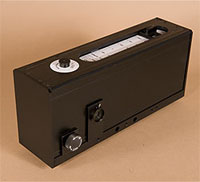 Swamp Optics for its BOA (Bother-free Optimized Arrangement) Pulse Compressor for shortening ultrashort pulses. The innovative BOA Compressor is a simple, compact and inexpensive pulse compressor that uses only one prism, a roof mirror and a precisely manufactured corner cube to reflect the beam back to the prism precisely parallel with the beam entering it. This automatically aligned arrangement avoids all of the problematic beam distortions of two- and four-prism designs (including angular dispersion, spatial chirp, and pulse-front tilt).
Swamp Optics for its BOA (Bother-free Optimized Arrangement) Pulse Compressor for shortening ultrashort pulses. The innovative BOA Compressor is a simple, compact and inexpensive pulse compressor that uses only one prism, a roof mirror and a precisely manufactured corner cube to reflect the beam back to the prism precisely parallel with the beam entering it. This automatically aligned arrangement avoids all of the problematic beam distortions of two- and four-prism designs (including angular dispersion, spatial chirp, and pulse-front tilt).
Only the corner-cube needs to be moved to tune the group-delay dispersion (GDD) over a wide range of values. Only the single prism angle needs to be rotated when the input wavelength changes. Also, because the prism-corner-cube distance is tuned (and not the prism insertion as in conventional compressors), the BOA Compressor can accommodate pulses with large, as well as small, bandwidths. The Optics Prism Award was presented by Stephen Krenitsky of Schott North America.
Other Light Sources
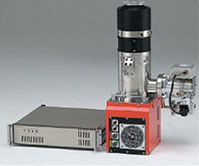 Hamamatsu Corp. for its 160 kV Open-Type Microfocus X-ray Source, a microfocus x-ray source (MFX) with .25 µm resolution for x-ray nondestructive inspection and computed tomography. A small focal point prevents blurring of x-ray images and delivers a sharp enlarged image. The award was presented by Jennifer Ernst of the Palo Alto Research Center.
Hamamatsu Corp. for its 160 kV Open-Type Microfocus X-ray Source, a microfocus x-ray source (MFX) with .25 µm resolution for x-ray nondestructive inspection and computed tomography. A small focal point prevents blurring of x-ray images and delivers a sharp enlarged image. The award was presented by Jennifer Ernst of the Palo Alto Research Center.
Detectors, Sensing and Imaging Systems
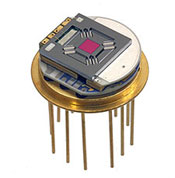
InfraTec Infrared LLC for its MEMS (microelectromechanical systems) tunable Fabry-Perot Interferometer Microspectrometer for infrared absorption spectroscopy. The device targets mid-wave infrared gas analyzer and spectroscopic applications to identify substances by detecting their unique absorption signatures. It is based on a bulk micromachined spectrally tunable Fabry-Perot interferometer with an electrostatically tuned air cavity integragted into an infrared detector. The award was presented by Upendra Singh of the NASA Langley Research Center.
Analytical, Test and Measurement
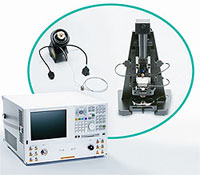 Agilent Technologies for its Scanning Microwave Microscopy, and Lehighton Electronics Inc. for its 1605 Mobility Unit. Agilent's scanning microwave microscopy mode is an atomic force microscopy method designed to enable quantitative electromagnetic materials characterization at high resolution.
Agilent Technologies for its Scanning Microwave Microscopy, and Lehighton Electronics Inc. for its 1605 Mobility Unit. Agilent's scanning microwave microscopy mode is an atomic force microscopy method designed to enable quantitative electromagnetic materials characterization at high resolution.
Lehighton's mapping unit measures electron mobility, sheet resistance, carrier concentration and density in a noncontact, nondestructive manner, eliminating destruction of expensive wafers for measurement. The award was presented by John Dexheimer of First Analysis and Lightwave Advisors.
Photonics Systems
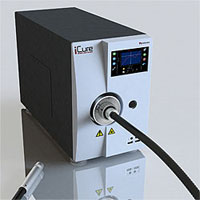 IRphotonics for its iCure Thermal Spot Curing System, which provides localized heat via high-intensity infrared radiation in a portable unit that can be integrated into a production line. The award was presented by Karl Spanner of Physik Instrumente.
IRphotonics for its iCure Thermal Spot Curing System, which provides localized heat via high-intensity infrared radiation in a portable unit that can be integrated into a production line. The award was presented by Karl Spanner of Physik Instrumente.
Photonics Processes
 Linden Photonics, for its strong-tether fiber optic cable (STFOC). The company's patented STFOC uses extruded liquid crystal polymer on commercial-grade optical fibers. The STFOC has moisture-barrier properties and eliminates the need for metalized fiber in hermetic packaging of optoelectronic components. The award was presented by Gary Speigel of Newport Corp.
Linden Photonics, for its strong-tether fiber optic cable (STFOC). The company's patented STFOC uses extruded liquid crystal polymer on commercial-grade optical fibers. The STFOC has moisture-barrier properties and eliminates the need for metalized fiber in hermetic packaging of optoelectronic components. The award was presented by Gary Speigel of Newport Corp.
Life Sciences
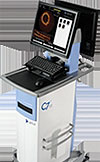 LightLab Imaging Inc. for its C7-XR Optical Coherence Tomography System. LightLab's C7-XR frequency-domain system employs advanced photonics technologies to provide cardiologists with an interior view of coronary arteries. Its ultrafast imaging speed, micron-scale resolution and 3-D visualization capabilities streamline the clinician's work flow and redefine the possibilities of interventional cardiology imaging.
LightLab Imaging Inc. for its C7-XR Optical Coherence Tomography System. LightLab's C7-XR frequency-domain system employs advanced photonics technologies to provide cardiologists with an interior view of coronary arteries. Its ultrafast imaging speed, micron-scale resolution and 3-D visualization capabilities streamline the clinician's work flow and redefine the possibilities of interventional cardiology imaging.
Sustainable/Green Technology
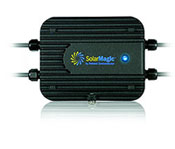 National Semiconductor's SolarMagic optimizer provides an electronic solution to long-standing challenges with solar arrays, enabling systems to realize their full power-producing potential. Using advanced algorithms and mixed-signal technology. SolarMagic minimizes the negative effects of panel mismatch caused by real-world conditions such as system aging, varied tilts and orientations, and debris or shade. The award was presented by Steve Eglash, a consultant to the National Renewable Energy Laboratory.
National Semiconductor's SolarMagic optimizer provides an electronic solution to long-standing challenges with solar arrays, enabling systems to realize their full power-producing potential. Using advanced algorithms and mixed-signal technology. SolarMagic minimizes the negative effects of panel mismatch caused by real-world conditions such as system aging, varied tilts and orientations, and debris or shade. The award was presented by Steve Eglash, a consultant to the National Renewable Energy Laboratory.
The celebratory mood of the evening turned poignant when Laurin Publishing Co. President Thomas Laurin paid tribute to his sister, Diane Laurin, who was instrumental in creating the Prism Awards last year and who died suddenly in August. Tom said Diane was influential in helping the industry, 30 years ago, embrace the all-encompassing name "photonics" to define itself.
In honor of Diane's legacy in the industry, Tom announced Laurin Publishing was donating funds in her memory to the SPIE Scholarship Fund to help students in the industry pursue their careers.
For more information on the Prism Awards, visit: www.photonicsprismawards.com
/Buyers_Guide/QPC_Lasers_Inc/c12367